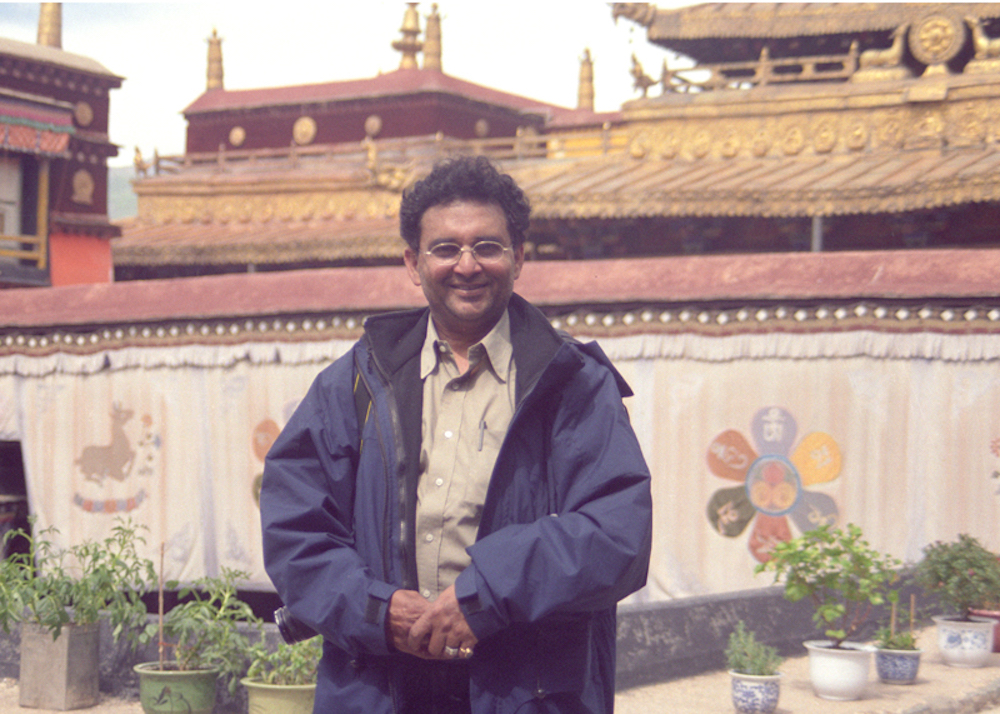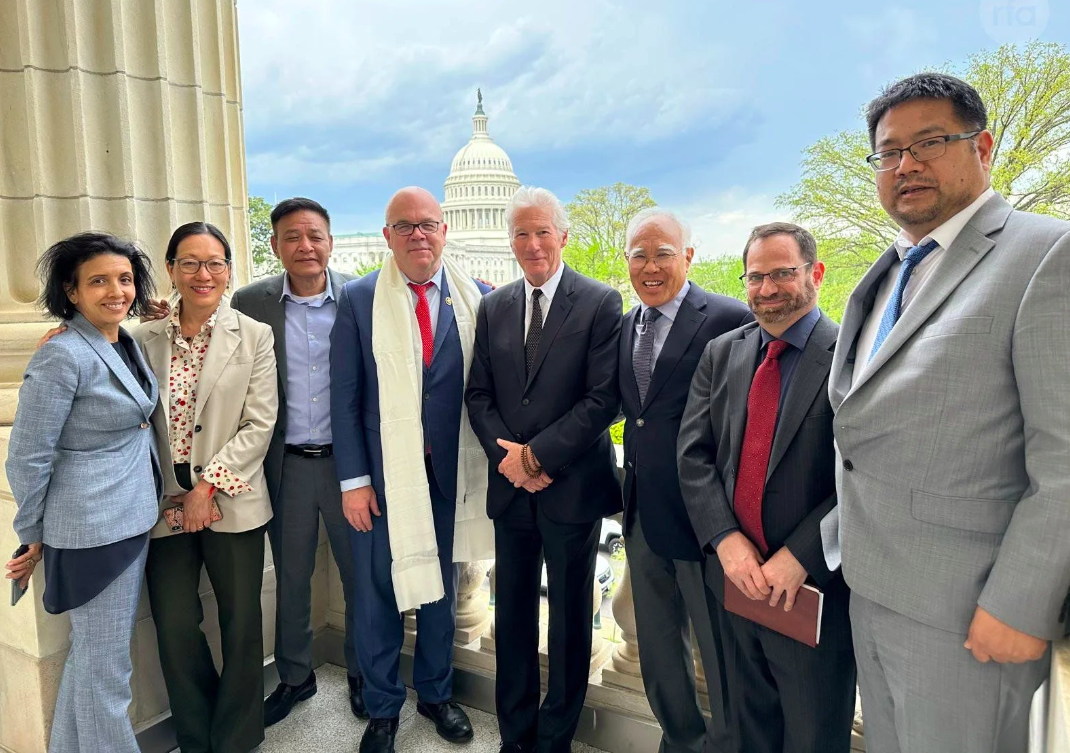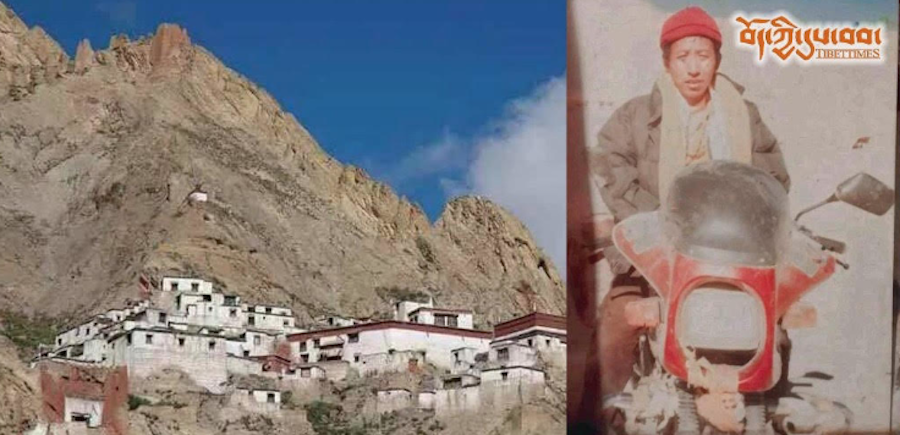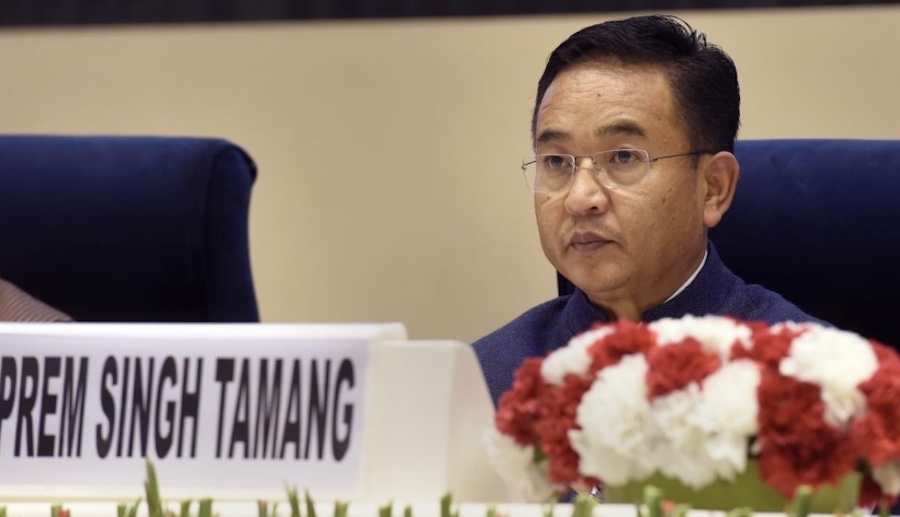By Vijay Kranti
(Part of the ‘My journey through the Tibetan mindscape’ series)
It was quite a different world in those days of mid 1960s. Things would take their own time to help you keep pace with an already slow moving world around you. I can’t think of anything other than the metre-gauge Kangra-Valley railway toy train which could qualify to be a more honest symbol of the pace of life in those days. This train connects Pathankot of Punjab with Joginder Nagar in adjoining Himachal Pradesh. The train would lazily chug on behind a coal fired railway engine and take ions to cover 164 km to reach Joginder Nagar. Most travellers to places like Kangra, Dharamshala, Palampur and Joginder Nagar would prefer jam packed, squeaky but much faster buses of Himachal Roadways over this train. Yet it remained the first choice for me and my younger brothers during our annual summer holidays which we used to spend at our late grandfather’s home in Pathankot.
One obvious convenience was that this part of our journey would come as a bonus over the already free railway-pass that our family was entitled to as a railwayman’s family. Although our real destination from Delhi used to be Pathankot, yet my father would register Joginder Nagar as our final destination with a break-journey at Pathankot in the pass application form. That gave us a choice to have an extra free joy ride to Joginder Nagar and back to Pathankot on this train on any day of our choice. However, the real attraction of this part of our rail journey was the thrill and fun associated with the snail speed of this toy train and beautiful views of valleys, jungles, water falls and tunnels along the way. The journey offered stunning views of snow caped Dhauladhar peaks of the majestic Himalayas from many points on the way.
The real fun of the journey from Pathankot side would start only after crossing the plains around the Nurpur station. There were some points on the way where the single engine would fail to negotiate the steep ascend and would stop in its tracks to build up enough steam to start again. For a crazy boy like me, this was the right opportunity to get off the train and hang around for some additional fun. A few others like me would spot a mountain stream down below at a distance and would rush with their water bottles for a fresh fill of the real but unbranded natural mineral water. This exercise was, obviously, less for the love of water than for the fun and anxiety it would create for the onlookers. On one such occasion, when I miscalculated and was on the verge of being left behind by the moving train in the middle of a jungle, the angry guard demonstrated the real kind side of his heart by stopping the train for me.
This fun would take an altogether different dimension after Baijnath, a popular Hindu temple town that lies a few kilometres above Kangra and close to Bir, a popular destination for trekkers. Here the train would shed more than half of its bogies and another engine would join at the tail end to push it from behind to negotiate some extraordinary steep humps which punctuated the route till Joginder Nagar. It was fascinating to hear the two engines fine tuning their pull-push game. After a sequence of whistles from both ends, the two engines would starts simultaneously to take the train across the most difficult ascend which lied between the Baijnath and the Baijnath-Mandir railway station.
To our weird and, perhaps misplaced joy this effort would fail on more occasions than not. In such an event the train drivers would allow the train to roll back about half a kilometre so that the train could catch enough momentum again to negotiate the ascent. I remember on one such occasion it was only on the fourth attempt that the train could make it. I think it was this very fun which made me wait for our summer vacations more than the other joys of the holidays.
During one such journeys me and my younger brother decided to visit our relatives at Kangra, just half way between Joginder Nagar and Pathankot. From their home on one end of Kangra town, the view of snow peaked Dhauladhar presented an extraordinarily beautiful tapestry of snow peaks touching the sky in front of our face. During night the twinkling lights at a spot in the middle of horizon looked like a dance performance of an army of glow worms. Our hosts told us that the shiny spot was Lower-Dharamsala town and that Dalai Lama and his ‘Laambay’ lived at McLeod Ganj just above the main town which is also known as ‘Upper Dharamshala’.
It was many years later when I grew up into a journalist and started my lifelong interaction with the Tibetan people that I realised that every Tibetan was a ‘Lama’ for the local Himachalis. In their typical local ‘Pahari’ dialect, Lama is pronounced as ‘Laamba’ for which the plural is ‘Laambay’. Over half a Century later today, I find that the schizophrenic growth of McLeod Ganj from a nearly invisible place to an endless jungle of cement and concrete has outshined its poor elder cousin viz. Lower-Dharamsala’.
On our return journey to Pathankot, we decided to take the evening train which would start from Kangra station at around 8pm and would drop us at Pathankot in the early morning. However, the train arrived from Joginder Nagar only a little after 10pm that evening. Thanks to the routine electric failure or power shedding, the only electric bulb on the open air platform in the middle of a pine jungle had gone off much before the train arrived. For the two little school boys from a metropolitan city, this dark environ in the middle of a hill jungle was quite scary. Interestingly, the only consolation in this near total darkness was a couple of other local passengers and the melodious sound of a flute that someone was playing in the distance. It was first time in my life that I could feel the beauty and power of flute music. Many decades later now, I realize what a privilege it was to be part of an exclusive audience of less than five people in a natural amphitheatre of infinite size.
Only God knows why a train which would normally run near empty on normal days was packed to the brim that night. May be it was some religious festival somewhere in the neighbourhood. The worst compartment was the second class one for which we held our privileged free pass. But there was no space in the door of that compartment to enter. Finally we had to be content with some space on the floor of a third class compartment near the tail end of the train. Our experienced mother had tugged in a single-bed sheet in our luggage, knowing well that it would be handy for two of us in a windy journey. We found the sheet quite useful both as a shield against the dust on the floor as well as a tool to mark our exclusive territory to sleep on in a crowded train.
As we sat on the floor, I found two skinny legs stemming out of two funny looking shoes. It was a shabbily dressed middle aged Tibetan who was sitting on a seat with a one or two year old baby in his lap. Like all other passengers in the overcrowded compartment, he too sat squeezed between two co passengers. They both presented an interesting mix of similarities and contrast. The little boy was chubby and looked like a wax doll with his rounded cheeks and fair complexion. The man’s complexion was more close to weather beaten copper kettle and was full of deep wrinkles. But both had markedly glittering eyes which communicated comfort and ease. We quickly exchanged smiles. I could feel that this exchange made the man feel more comfortable amidst a crowd of strangers. The little boy in his lap took no time in understanding this newly found relationship. He quickly expressed it through a loud smile and tapping of my head with his stretched out hands. I responded with equal warmth by tickling his chubby cheeks and holding his little hand.
The compartment was too stuffy to breathe comfortably. But as soon as the train started moving, the stuffy air quickly yielded to a fragrant cool breeze from the surrounding pine jungle. Soon the little boy decided to upgrade our relationship. His tiny hand was now trying to hold on to my hair. Just one smile from me and he was pulling himself out of his father’s lap. Soon the little bundle of joy was in my lap. We were now communicating in a language of smiles and laughter. A strange, exotic smell of oil and herbs emanated from his head. There have been numerous occasions in past fifty years when a memory of this journey overwhelms my nostrils with same exotic fragrance.
A noisy commotion at the next halt shoved me out of my slumber. A new set of desperate passengers was here to find some space in the already jam packed compartment. Suddenly I discovered that two heavily built men in their mid forties were shouting at the Tibetan. One of them holding a polished bamboo stick was demanding the passengers sitting on the bench to squeeze and make space for him. They were not in uniform but the typical police cane and his bullying voice indicated that they could be policemen in civil clothes. His stick and eyes were more focused on the Tibetan who, obviously, looked more vulnerable and miserable than other passengers.
As the man tried to push his cane into the Tibetan’s chest, the fiery adolescent in me woke up with all the fire at its command. I shouted at the man and demanded him remove the stick from the Tibetan man. For a six feet bully this was too much a provocation from a little boy. In a fraction of a second the stick’s thick end was pressing against the middle of my forehead. Now I realized that I was facing two real policemen who were travelling without their uniform. “Oye! fitt rah apni jagah te. Zyada leadry mat dikhana. Warna.a.a!!” (Hey, mind your own business. Don’t try to behave like a leader. Else…), he shouted at me in typical policeman’s tone.
It seems that I was still left with enough energy to shout back, “But what is his fault? Why should you single him out in the crowd?” I could see some nodding faces in the crowd who did not approve of the policemen’s conduct. The bully too did not miss this public reaction. He quickly changed his stance to prove that there was something really wrong with the Tibetan guy. He was now trying to show as if he was interrogating a criminal. “Pataa nayeen kitthon aa jaande ne ye saale Cheenee! Apheem vechde ne ye saale Cheenee. Oye nikal kitthe rakkhi hai apheem? Nikal, saala chor da puttan na hoavay te…” (You don’t know where these Chinese come from? These Chinese are here to sell opium. Hey man! Take out your stuff and show me where are you keeping your opium stock? Take it out you son of a thief!!!”), he shouted at the man in hard hitting Punjabi accent.
To everyone’s surprise, the meek looking Tibetan shouted back in a loud voice in his broken Hindi, “Baaboo, humko Cheenee mutt bolna. Hum Cheenee nahin hai. Hum Tibbati hai. Cheenee mutt bolna humko…..” (Sir, don’t call me a Chinese. I am not a Chinese. I am a Tibetan. Don’t you dare call me a Chinese..). I was surprised by the courage and anger in his eyes. The guy looked more hurt by being taken for a Chinese than for being accused of being an opium seller or even being abused as a ‘Chor Da Puttar (‘son of a thief’). While others could read the sense of insult and desperation on the poor Tibetan’s face, I was amazed by the sense of his national pride and self-respect as a Tibetan.
The policeman seemed in no mood to give in. “Chup Kar Oye, Chor Da Puttar” (Shut up you son of a thief), thundered the man. He snatched the little cloth packet which the Tibetan was holding close to his chest. It was a small typical Tibetan stringed pouch with embroidered Tibetan motifs which was bulging with some round stuff. The policeman pulled the strings and dipped his fingers in to the bag with a beaming smile. Everyone was holding breath anticipating that the smart policeman was going to take out a lump of opium from the bag. As he moved out his fingers, dipped in some white powder, he smelled it with a confused look. But before he could ask about the stuff, the Tibetan spoke in a very soft voice, pointing his finger to the baby in my lap, “Baaboo, ye to Tsampa hai. Sattoo hai iss bacche ka khaana hai…” (Sir, its Tsampa – flour of roasted barley. Its food for my baby….).
Now it was the turn of both the policemen to look embarrassed with sheepish smile on their faces. Someone on the adjoining bench pulled them out of further embarrassment by offering some sitting space to them. Soon peace returned to the compartment as it always happens in an Indian railway train. I and my brother stretched out on our bed sheet once again. The Little baby was comfortably sleeping on my chest.
Next morning a sudden noise in the compartment woke me up. The train had just stopped at a station. Perhaps it was Guler from where some daily commuters were boarding for Pathankot. In sharp contrast to last night’s crowd, the compartment looked almost deserted. Later I was told that most of the passengers had got down at Jwalamukhi, a popular Hindu pilgrim centre during night. I suddenly realized that despite the chilly air in the compartment I was feeling warm. I discovered that this warmth was due to the blanket that covered me and my brother. The blanket smelled very different from our home blankets. “Whose blanket is this,” was the first question that hit me.
In a confused state of mind, I looked around to find out who had put the blanket on us during night? Only two faces I could recognize were the two policemen. One of them was looking out of the window with his chin resting on the same police stick that had affectionately greeted me last night. In a hesitating voice I asked the other guy, “Sir, do you know who put this blanket on us? We had only our bed sheet with us. Does it belong to you?”
Before this guy could respond, the man with the stick jumped into our discussion with a broad smile. “Yes. We found you both were shivering in the cold. So we decided to cover you up with our blanket. I hope it was comfortable?”, he said and extended his hand for the blanket. By this time my brother too had woken up. We quickly took off the blanket and handed it over to the guy with a big smile and a loud ‘thank you’. As this guy started folding the blanket he shouted at his colleague, “Oye apna teshion aa gaya hai. Utarna naheen hai kya? Oye chal jaldi kar. Gaddi chal payegi.” (Hey, our station has arrived. Don’t you want to get down? Be quick before the train starts moving.) And they jumped out of the seats in a flash, one holding the stick and the other one holding the blanket.
After the train had crossed another station, the little baby suddenly dawned on my mindscape. I could feel his warmth on my chest; his round cheeks; his smiling eyes. Like a film playback I could see the Tibetan man’s wrinkled face and eyes beaming with anger against being branded as a ‘Cheenee’ (Chinese)……. And then the exotic fragrance of the little baby’s head overwhelmed my nostrils. I suddenly realized that this smell was same as one emanated from the blanket…….. I was wondering who was the real ‘Chor Da Puttar’?
I don’t have the right answer to this question but over past fifty years this ‘Chor Da Puttar’ keeps visiting my mindscape frequently — accompanied by the warmth and anxieties of a cold, musical and eventful night; shiny eyes of a little baby; his oily fragrance; an angry man with a bullying stick; and the self-respecting anger of a Tibetan who was ready to handle the insult of being called a ‘Chor Da Puttar’ but not the ignominy of being called a ‘Cheenee’ (Chinese). This was my first ever encounter with a Tibetan.
(Views expressed are his own)
The author is a senior Indian journalist, photographer and a keen Tibet watcher for over four decades. During the first decade of 2000’s he visited Tibet many times on his self assigned learning and photo-expeditions.











3 Responses
This article reminded me of my winter vacation days when I was in school. We used to walk down from our settlement in Chowgan(Bir) to Ahju and then take the train from Ahju to Jogindernagar to watch movies. Those good old days! Thank you Mr. Kranti!
” schizophrenic growth of McLeod Ganj from a nearly invisible place to an endless jungle of cement and concrete has outshined its poor elder cousin viz. Lower-Dharamsala” writes Mr Kanti.
Mcleod Ganj and Forsythia Ganj were both not invisible in 1960s. The twin town was a hill post for the Brits, witnessed from the Anglican Church and burial graves of hundreds of English men.
Mcleod is again not an endless jungle of cement and concrete. Mcleod is cosmopolitian hamlet tugged into dense forest of high Himalayas where Tibetan style wood-made houses, Tibetan temples built along Chinese Tang era architecture and shabby stalls sit interspersed amongst high-end hotels, bars and spas.
A town doesn’t over take a other because it is an endless stream of concrete jungles and therefore highly developed. Theres always a Tree Factor.
Nostalgic piece on Raj era stream locomotives. Mr VK, can you write an application to Modi to extend Kangra Valley Toy train to Lower Dharamsala or to Gaggal Airport ? With sky cable on way, this will generate huge revenue for the locals.